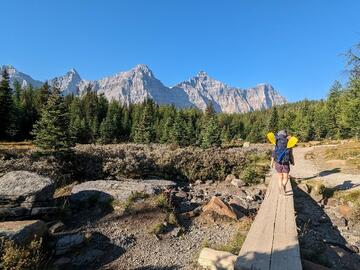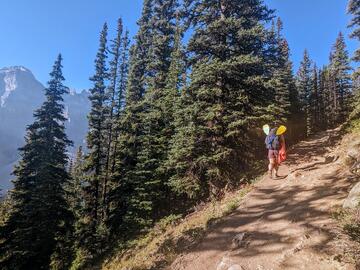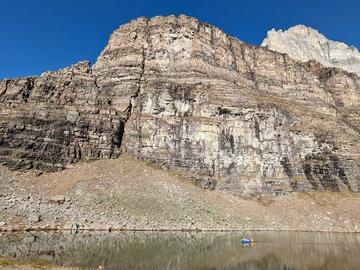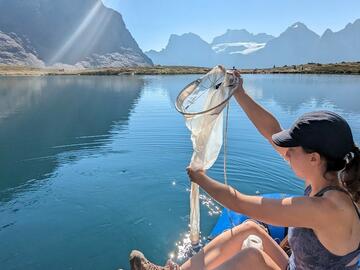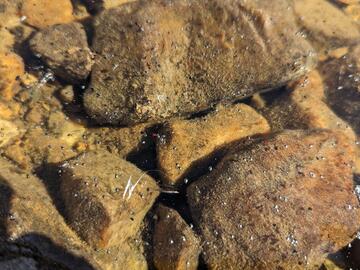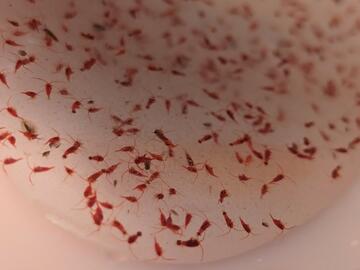Oct. 3, 2023
Notes from the field: Alberta’s changing alpine lakes

Spending a summer visiting Moraine Lake, Lake O’Hara and other world-famous Rockies destinations is a bucket-list trip for many, but for Colleen Dawson it’s just the job.
Dawson is a master’s student at the University of Alberta in Dr. Rolf Vinebrooke’s lab. She has spent the summer, along with her research assistants, at the University of Calgary’s Barrier Lake Field Station so that she can easily visit nearby mountain sites to collect data for her research on climate change and alpine lakes.
Dawson’s research has two components; field sampling and experimental. For the experimental part of her project, Dawson and her assistants took water samples from 10 alpine lakes. These samples were used to inoculate 1,000-litre water tanks onsite at the Barrier Lake Field Station, transferring the phytoplankton and zooplankton communities from the lakes into the tank environments.
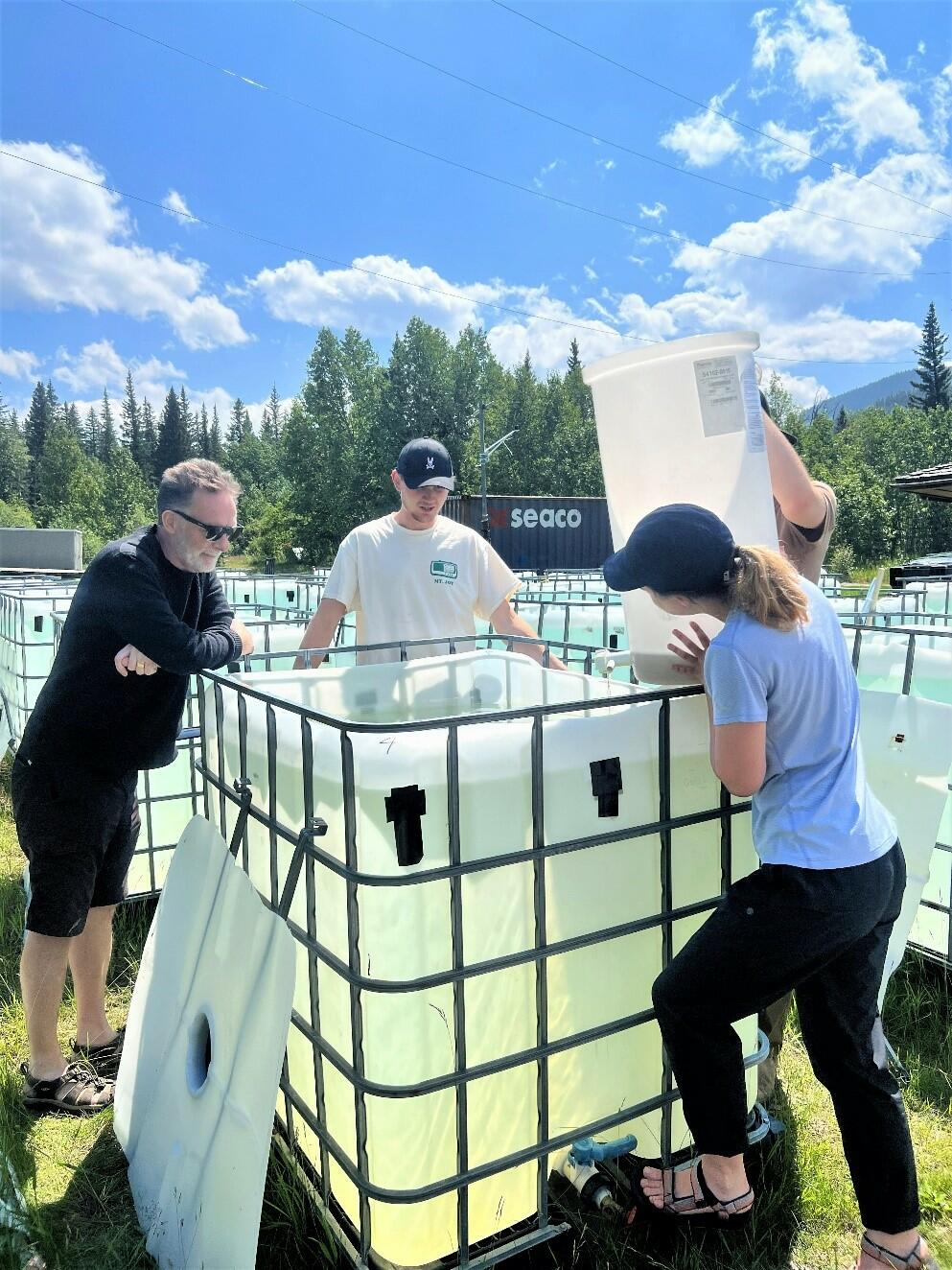
Sample tanks are prepared at the Barrier Lake Field Station by Colleen Dawson (master’s student), Cordelius Hultberg (research assistant), Matthew Elphick (research assistant) and lab supervisor Dr. Rolf Vinebrooke.
Adrienne Cunnings
Some tanks were left as controls, and others were subject to various treatments to simulate the effects of a warming climate. Glacial flour, the sediment responsible for giving glacial lakes their unique blue colour, was added to some tanks to model the expected increase of glacial input into alpine lakes as glaciers melt at a faster.
Other tanks had a dissolved organic matter leachate added, which was made by soaking things like leaves and twigs from alpine vegetation in water, similar to making tea. Alpine lakes which have not previously had shoreline vegetation are expected to see the emergence of such plants, and therefore have increased amounts of organic matter from these plants, as the treeline moves upward in elevation due to a warming climate.
Some tanks were also treated with both glacial flour and dissolved organic matter.
The field sampling component of Dawson’s research involved revisiting each of the 10 alpine lakes that were sampled, three times each throughout the summer season. Although spending the summer hiking may seem like a dream, the reality is slightly less polished.
Chatting with Dawson and Cordelius Hultberg, an undergraduate research assistant, they describe experiencing every kind of weather while hiking into one of their sites at Zigadenus Lake, near Skoki Lodge: “Snow, rain, hail, sun, wind and a singular loud clap of thunder.” And that was all in one day!
They also jokingly nicknamed Moraine Lake, More-Rain Lake due to their tendency to experience wet weather on their sampling days there. However, when I joined the team on Aug. 28, it seemed the spell was broken as we had a beautiful sunny day.
Along with the hiking and the weather, mountain research also means carrying in your equipment. Dawson and Hultberg both hauled heavy packs, loaded with an inflatable boat and a wide array of sampling equipment on the 10-kilometre round trip hike from Moraine Lake to their site at Sentinel Lake.
Once at the lake, they inflated the small boat, and took various measurements and samples. The first step was to use a vacuum filter to slowly pass a water sample through a small piece of filter paper. The filter captures all the phytoplankton present in the sample, which can then be analyzed in a lab.
Pigment analysis will be used to identify species of phytoplankton present, and to quantify the amount of Chlorophyll A in the sample, which will be used for biomass estimations. Water samples are also taken back to the University of Alberta to be analyzed for dissolved organic carbon, as well as nitrogen and phosphorous concentrations. They will also be inspected under a microscope to view the individual phytoplankton.
A special tube is used to take this sample from the full depth of the lake, ensuring the data is not just from the surface or the bottom. Other tests included using a water quality meter to measure pH, temperature, turbidity and other parametres at each meter of the water column. The team also uses two different methods to measure light penetration in the water column, a simple Secchi disc and a much more complex (and much heavier) light meter which measures photosynthetic active radiation.
Finally, a net is used to capture a sample of zooplankton, which will be brought back to the lab. Dawson says identifying the zooplankton is thankfully quite simple, as there are typically only a handful of species present in these alpine lakes, compared to much more diverse lower-elevation lakes. In our sample we can easily see the distinctly red-coloured Hesperodiaptomus arcticus and a brownish Daphnia species.
Following our day together, Dawson and Hultberg had just a few more field days before they packed up and headed back to Edmonton. Dawson will spend the fall and winter analyzing the data she has collected, and Hultberg will finish the final semester of his undergraduate degree. Both are grateful to have had a summer full of hiking, exploring and doing scientific research in some of the most beautiful places in the Rockies.
Research Support Fund
The federal government’s Research Support Fund (RSF) assists Canadian post-secondary institutions and their affiliated research hospitals and institutes with the expenses associated with managing the research funded by Tri-Council agencies. The Research Support Fund helps the university create an environment where researchers can focus on their research, collaborate with colleagues, and translate their discoveries and innovations. Read more about how UCalgary uses the Research Support Fund.


